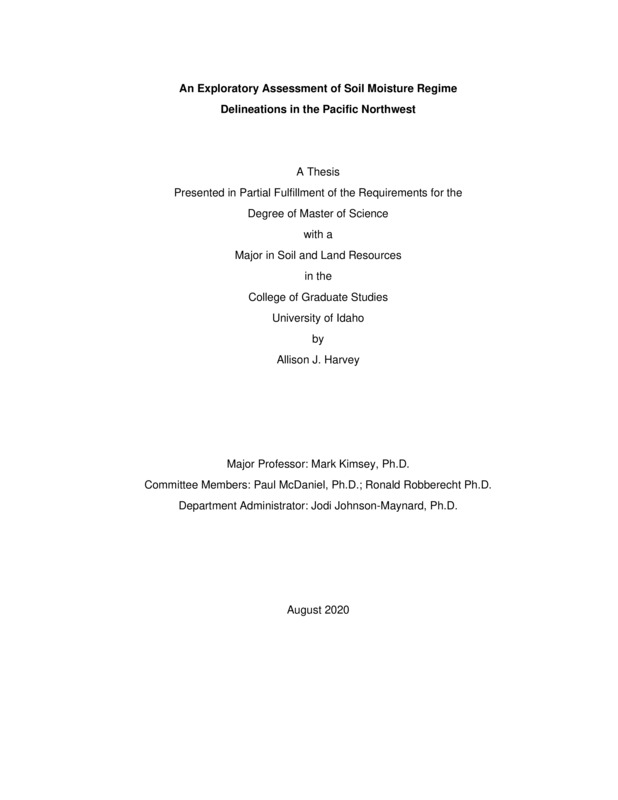An Exploratory Assessment of Soil Moisture Regime Delineations in the Pacific Northwest
Harvey, Allison J. (2020-05). An Exploratory Assessment of Soil Moisture Regime Delineations in the Pacific Northwest. Theses and Dissertations Collection, University of Idaho Library Digital Collections. https://www.lib.uidaho.edu/digital/etd/items/harvey_idaho_0089n_11892.html
- Title:
- An Exploratory Assessment of Soil Moisture Regime Delineations in the Pacific Northwest
- Author:
- Harvey, Allison J
- ORCID:
- 0000-0001-9971-174X
- Date:
- 2020-05
- Keywords:
- Habitat Types Soil Soil Moisture Regimes Soil Science Soil Taxonomy
- Program:
- Plant, Soil and Entomological Sciences
- Subject Category:
- Soil sciences; Forestry; Range management
- Abstract:
-
Created concurrent with Great Plains cropping systems along a shallow precipitation gradient, the translation of soil moisture regimes (SMRs) to the American West may not account for the latter’s variable precipitation distribution and natural vegetation. While this was noted shortly after the regimes’ genesis, Western land managers were still left to infer SMRs along vegetative communities using Great Plains definitions and field knowledge alone. To ground truth these vegetative associations with SMR definitions, four transects of five monitoring sites each were placed along gradients of increasing precipitation to capture respective transitions from aridic to xeric and xeric to udic SMRs within relevant plant communities and land uses of Major Land Resource Areas (MLRA) 2 & 3, 10, 12, and 43A. MLRA 10 was predicted to traverse aridic and xeric SMRs while the remaining transects would represent the transition from xeric to udic. Sites representing MLRAs 2 & 3 were all measured as having a udic SMR. Within MLRA 10, sites were measured as having a udic SMR. MLRA 12 was the most diverse, containing ustic, aridic, and udic SMRs at sites 1 and 2, 3 and 4, and 5, respectively. Finally, MLRA 43A, was measured as having a udic SMR at sites 2-5 and an ustic SMR at site 1. Though 10 years of data is necessary to officially assign a SMR, the radical misalignment between predicted and actual SMRs indicates that either regime definitions do not adequately reflect significant changes in Western vegetation as depicted by local land managers, or vegetative delineations need to adjust to fit instated SMR definitions. Considering the former, when setting the soil moisture threshold to 10% volumetric soil moisture instead of the current wilting point volumetric soil moisture, the predicted soil moisture regimes better fit actual soil moisture measurements. Regardless, more monitoring is necessary to take definitive action.
- Description:
- masters, M.S., Plant, Soil and Entomological Sciences -- University of Idaho - College of Graduate Studies, 2020-05
- Major Professor:
- Kimsey, Mark
- Committee:
- McDaniel, Paul; Robberecht, Ron
- Defense Date:
- 2020-05
- Identifier:
- Harvey_idaho_0089N_11892
- Type:
- Text
- Format Original:
- Format:
- application/pdf
- Rights:
- In Copyright - Educational Use Permitted. For more information, please contact University of Idaho Library Special Collections and Archives Department at libspec@uidaho.edu.
- Standardized Rights:
- http://rightsstatements.org/vocab/InC-EDU/1.0/

